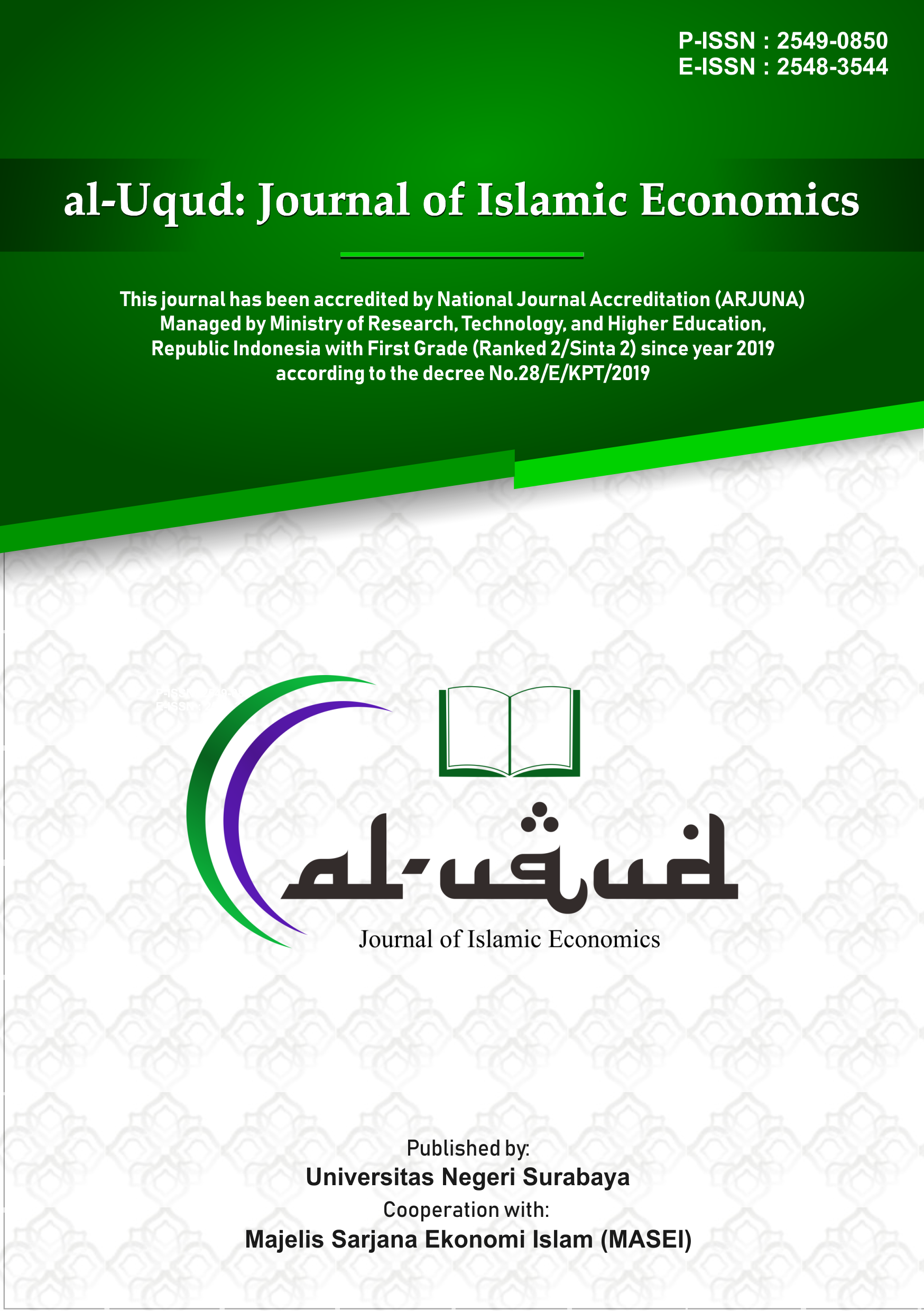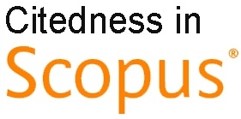Islamic Banking Efficiency in Indonesia and Malaysia: Two Stages Data Envelopment Window Analysis
DOI:
https://doi.org/10.26740/al-uqud.v5n2.p%25pKeywords:
Efficiency, Islamic Banks, Data Envelopment Window Analysis, Tobit Model.Abstract
This study aimed to evaluate the efficiency of Islamic banks in Indonesia and Malaysia and examine the determinants of their efficiency in 2015-2019 using a two-stage data development window analysis approach. The research involves 13 Indonesian Islamic banks and 16 Malaysian Islamic banks. The first test step using the Data Envelopment Window Analysis (DEWA) approach has shown that the Islamic Bank's efficiency in managing resources is inefficient. The second research process using the Tobit model shows that the Capital Adequacy Ratio (CAR), Return on Asset (ROA), Non-Performing Financing (NPF), and Deposit Ratio Financings (FDR) do not have a significant impact on the efficiency of Indonesian Islamic Banking. Though CAR has significant positive effects on banking efficiency in Malaysia, NPF has a significant impact on Malaysian Islamic banks' efficiency. This study implies that the banking industry players increase their efficiency, mainly to enhance the amount of finance directed more towards the production sector, to increase the Islamic banking industry's market share in both countries.
References
Abbas, M., Azid, T., & Hj Besar, M. H. A. (2016). Efficiency, effectiveness and performance profile of Islamic and conventional banks in Pakistan. Humanomics, 32(1), 218. https://doi.org/10.1108/H-09-2015-0058
Ahmad, S., & Rahman, A. R. A. (2012). The efficiency of Islamic and conventional commercial banks in Malaysia. International Journal of Islamic and Middle Eastern Finance and Management, 5(3), 241263. https://doi.org/10.1108/17538391211255223
Ahmad, W., & Luo, R. H. (2010). Comparison of banking efficiency in Europe: Islamic versus conventional banks (pp. 361389). https://doi.org/10.1108/S1569-3767(2010)0000011016
Asmild, M., Paradi, J. C., Aggarwall, V., & Schaffnit, C. (2004). Combining DEA Window Analysis with the Malmquist Index Approach in a Study of the Canadian Banking Industry. Journal of Productivity Analysis, 21(1), 6789. https://doi.org/10.1023/B:PROD.0000012453.91326.ec
Basri, M. F., Muhamat, A. A., & Jaafar, M. N. (2019). A Descriptive Study on Bank Performance in Malaysia: Domestic vs. Foreign Islamic Banks. International Journal of Academic Research in Business and Social Sciences, 9(1). https://doi.org/10.6007/IJARBSS/v9-i1/5507
Cambridge Institute of Islamic Finance. (2019). Global Islamic Finance Report (GIFR) 2019.
Charnes, A., Clark, C. T., Cooper, W. W., & Golany, B. (1984). A developmental study of data envelopment analysis in measuring the efficiency of maintenance units in the US air forces. Annals of Operations Research, 2(1), 95112. https://doi.org/10.1007/BF01874734
Charnes, A., Cooper, W. W., & Rhodes, E. (1978). Measuring the Efficiency of Decision Making Units. European Journal of Operational Research, 2(6), 429444. https://doi.org/10.1016/0377-2217(78)90138-8
Endri. (2008). Efisiensi Teknis Perbankan Syariah di Indonesia. Finance and Banking Journal, 10(2). http://journal.perbanas.id/index.php/jkp/article/view/148
Fathony, M. (2012). Estimasi dan Faktor-faktor yang Memengaruhi Efisiensi Bank Domestik dan Asing di Indonesia. Jurnal Keuangan Dan Perbankan, 16(2), 223237. http://jurnal.unmer.ac.id/index.php/jkdp/article/view/1063
Firdaus, M. F., & Hosen, M. N. (2013). Efisiensi Bank Umum Syariah Menggunakan Pendekatan Two-Stage Data Envelopment Analysis. Buletin Ekonomi Moneter Dan Perbankan, 16(2), 167188. https://doi.org/10.21098/bemp.v16i2.31
Ghozali, M., Azmi, M. U., & Nugroho, W. (2019). Perkembangan Bank Syariah di Asia Tenggara: Sebuah Kajian Historis. Falah: Jurnal Ekonomi Syariah, 4(1), 44. https://doi.org/10.15408/thd.v1i2.8430
Hidayati, N., Siregar, H., & Pasaribu, S. H. (2017). Determinant of Efficiency of The Islamic Banking in Indonesia. Buletin Ekonomi Moneter Dan Perbankan, 20(1), 2948. https://doi.org/10.21098/bemp.v20i1.723
IFSB. (2019). Islamic Financial Services Industry Stability Report 2019.
Ismail, F., Shabri Abd. Majid, M., & Rahim, R. A. (2013). Efficiency of Islamic and conventional banks in Malaysia. Journal of Financial Reporting and Accounting, 11(1), 92107. https://doi.org/10.1108/JFRA-03-2013-0011
Komijani, A., & Taghizadeh-Hesary, F. (2018). Routledge Handbook of Banking and Finance in Asia (U. Volz, P. J. Morgan, & N. Yoshino (eds.)). Routledge. https://doi.org/10.4324/9781315543222
Lutfiana, R. H., & Yulianto, A. (2015). Determinan Tingkat Efisiensi Bank Umum Syaria di Indonesia (Pendekatan Two Stage DEA). Accounting Analysis Journal, 4(3). https://doi.org/10.15294/aaj.v4i3.8313
Mala, C. M. F., Rodoni, A., & Yaman, B. (2018). Market Power and Efficiency of Islamic Banking and Conventional Banking in Indonesia. Global Review of Islamic Economics and Business, 6(2), 131. https://doi.org/10.14421/grieb.2018.062-05
Khan, M. M., & Bhatti, I. M. (2008). Islamic Banking and Finance: on Its Way to Globalization. Managerial Finance, 34(10), 708725. https://doi.org/10.1108/03074350810891029
Mokhtar, H. S. A., Abdullah, N., & Alhabshi, S. M. (2008). Efficiency and competition of Islamic banking in Malaysia. Humanomics, 24(1), 2848. https://doi.org/10.1108/08288660810851450
Nguyen, T. P. T., Roca, E., & Sharma, P. (2014). How efficient is the banking system of Asias next economic dragon? Evidence from rolling DEA windows. Applied Economics, 46(22), 26652684. https://doi.org/10.1080/00036846.2014.909578
OJK. (2019). Laporan Tahunan Otoritas Jasa Keuangan.
Pambuko, Z. B. (2016). Determinan Tingkat Efisiensi Perbankan Syariah Di Indonesia: Two Stages Data Envelopment Analysis. Cakrawala: Jurnal Studi Islam, 11(2), 178194. https://doi.org/10.31603/cakrawala.v11i2.249
Phan, H. T., Anwar, S., & Alexander, W. R. J. (2018). The determinants of banking efficiency in Hong Kong 2004-2014. Applied Economics Letters, 25(18), 13231326. https://doi.org/10.1080/13504851.2017.1420870
Prasetyo, P. P., Pantas, P. E., Ashar, N. J., & Pertiwi, F. R. (2020). Performance Comparison of Islamic Banking in Indonesia and Malaysia: Islamicity Performance Index Approach. Journal of Islamic Economics Perspectives, 2(1), 92103. http://jurnalfebi.iain-jember.ac.id/index.php/JIEP/article/view/30
Rama, A. (2015). Analisis Deskriptif Perkembangan Perbankan Syariah di Malaysia. The Journal of Tauhidinomics, 1(2), 105123. https://doi.org/10.15408/thd.v1i2.8430
Rozzani, N., & Rahman, R. A. (2013). Determinants of Bank Efficiency: Conventional versus Islamic. International Journal of Business and Management, 8(14). https://doi.org/10.5539/ijbm.v8n14p98
Rusydiana, A. S. (2018). Efisiensi dan Stabilitas Bank Umum Syariah di Indonesia. Akuntabilitas, 11(2). https://doi.org/10.15408/akt.v11i2.7033
Sathye, M. (2003). Efficiency of banks in a developing economy: The case of India. European Journal of Operational Research, 148(3), 662671. https://doi.org/10.1016/S0377-2217(02)00471-X
Setiawan, C., Hasan, T., & Hassan, M. K. (2017). Non-Performing Loans and Bank Efficiency of Conventional and Islamic Banks in the Organization of Islamic Cooperation (OIC) Countries. Journal of Islamic Economics Banking and Finance, 13(4), 1843. https://doi.org/10.12816/0051000
Shah, S. Q., & Jan, R. (2014). Analysis of Financial Performance of Private Banks in Pakistan. Procedia - Social and Behavioral Sciences, 109, 10211025. https://doi.org/10.1016/j.sbspro.2013.12.583
Shawtari, F. A., Abdelnabi Salem, M., & Bakhit, I. (2018). Decomposition of efficiency using DEA window analysis. Benchmarking: An International Journal, 25(6), 16811705. https://doi.org/10.1108/BIJ-12-2016-0183
Shawtari, F. A., Ariff, M., & Abdul Razak, S. H. (2015). Efficiency assessment of banking sector in Yemen using data envelopment window analysis. Benchmarking: An International Journal, 22(6), 11151140. https://doi.org/10.1108/BIJ-10-2014-0097
Socol, A., & D?nule?iu, A. E. (2013). Analysis Of The Romanian Banks Performance Through Roa, Roe And Non-Performing Loans Models. Annales Universitatis Apulensis Series Oeconomica, 15(2), 594604. https://ideas.repec.org/a/alu/journl/v2y2013i15p24.html
Solihin, S., Achsani, N. A., & Saptono, I. T. (2016). The Islamic Banking and The Economic Integration in ASEAN. Buletin Ekonomi Moneter Dan Perbankan, 19(1), 81106. https://doi.org/10.21098/bemp.v19i1.601
Sufian, F. (2009). Determinants of bank efficiency during unstable macroeconomic environment: Empirical evidence from Malaysia. Research in International Business and Finance, 23(1), 5477. https://doi.org/10.1016/j.ribaf.2008.07.002
Wahab, A. H. A., & Haron, R. (2017). Efficiency of Qatari banking industry: an empirical investigation. International Journal of Bank Marketing, 35(2), 298318. https://doi.org/10.1108/IJBM-07-2016-0090
Webb, R. (2003). Levels of efficiency in UK retail banks: a DEA window analysis. International Journal of the Economics of Business, 10(3), 305322. https://doi.org/10.1080/1357151032000126256
Yahya, M. H., Muhammad, J., & Hadi, A. R. A. (2012). A Comparative Study on The Level of Efficiency Between Islamic and Conventional Banking Systems in Malaysia. International Journal of Islamic and Middle Eastern Finance and Management, 5(1), 4862. https://doi.org/10.1108/17538391211216820
Downloads
Published
How to Cite
Issue
Section
License
Copyright (c) 2021 al-Uqud : Journal of Islamic Economics

This work is licensed under a Creative Commons Attribution 4.0 International License.
CC BY 4.0 Abstract views: 903
,
Abstract views: 903
, PDF Downloads: 780
PDF Downloads: 780








